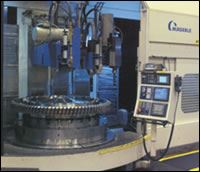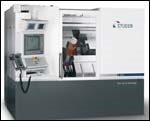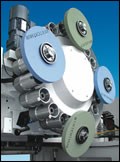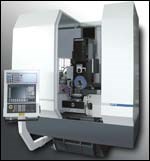Milling On A Grinding Machine
A grinding machine is not a machining center, but it can sometimes take on milling and drilling (or even turning) to make the overall process more efficient.
Share




When the word “multitasking” is applied to machine tools, the term generally refers to a machine that is capable of both turning and milling. That definition is fine as far as it goes. However, turning and milling are two fairly similar operations. They both use a cutting edge to make a chip, and they both occur at roughly the same stage in a production process. If the argument for multitasking has to do with reducing both the delay and the potential for error that come from transporting parts between different machines, then that argument gains strength if the multitasking machine can combine operations that are even further removed from one another in the production process.
For example, what about combining milling and grinding?
Grinding, of course, is typically thought of as a finishing operation. Milling is more about removing a stock envelope. In many plants, these two operations are performed in different locations. In an even larger number of plants, they are performed by different employees who have different skills. Combining the two operations would not seem to be an obvious choice.
However, certain profile grinding machines have developed in the direction of this type of multitasking, even when combining operations was not necessarily the goal. The MFP-TC grinding machine pictured, from Mägerle (represented in the United States by United Grinding Technologies, Miamisburg, Ohio), provides an example. To support an increasing role for creep-feed grinding (a higher-metal-removal rate process than grinding just for finish), this machine features a powerful spindle and stiff hydrostatic ways. Further, because wheel types such as conventional abrasive, plated CBN and vitrified CBN all excel in different applications, the machine has been equipped with the capability to store different wheels and automatically switch between them.
This latter feature relies on proven technology. Specifically, it relies on a toolchange arm like that of a machining center, along with toolholders (or wheelholders in this case) that use the HSK interface of a machining center’s toolholders. Taken together, this machine’s tool changing, spindle power and rigidity produce the equivalent of a highly capable machining center. Precise heavy milling can be performed on this machine, and milling and drilling tools can be stored in the tool magazine alongside the grinding wheels.
Minimal Milling
Chris Stine is a vice president of United Grinding Technologies. He says performing chip-making operations such as milling and drilling on a grinding machine is best suited to certain types of parts. It also requires a particular mindset about production.
For a part to benefit from milling or drilling on a grinder, the cycle should consist of mostly grinding. The MFP-TC machine cited above remains a grinder first and foremost, offering precision beyond what might be associated with even a higher-end machining center, he says. As a result, the machine can’t compete economically against a machining center if traditional metalcutting makes up most of the work.
However, many ground parts do feature a small but critical amount of this metalcutting. Even on a grinding machine equipped with multiple wheels and capable of high metal removal rates, there are plenty of features that simply cannot be ground. Holes, pockets and slots that don’t run completely through the workpiece are examples. When the part has one or more features such as these, performing these cuts on the grinder can save considerable cost by eliminating the need to set up on multiple machines. This is particularly true for parts such as airfoils, in which the location of machined features may be defined with respect to ground surfaces that have complex geometries.
Another argument for consolidating operations relates to the part’s size. Large parts magnify the savings in floor space that might result from combining grinding and machining center operations into one machine. Labor savings might also be more significant. The bigger the part, the better it is to set it up in just one place.
For particularly large parts, Mr. Stine says that the range of potential operations expands to include turning. A rotary table that can turn at 70 rpm can deliver 1,500 sfm of cutting speed to a turning tool that cuts at a diameter of 7 feet. This is exactly the solution that GE Gas Turbines (Greenville, South Carolina) adopted for machining large turbine wheels. Parts that used to be machined on a grinder, a vertical lathe and a boring mill now receive all of this machining on one Mägerle machine tool. The change saves about 6 hours of setup time and 2 days of queue time, according to engineers at the plant. Overall, there has been a 30 percent cycle time reduction.
Process Perspective
These savings overcome the fact that the multitasking grinder is unlikely to be cost-efficient when it comes to milling or turning as isolated operations. Accepting this seeming inefficiency within the machining cycle, for the sake of a more efficient process overall, is part of the recipe for implementing these machines effectively. Different manufacturing organizations view their costs differently, and the need for this process-wide outlook is part of why identifying the right applications for these machines is not necessarily cut and dried.
A traditional manufacturing mindset looks at a part’s features and tolerances to see the particular machine tools best suited to produce all of that geometry. This part-centered perspective may optimize machining time and machining cost, but it may do so at the expense of less easily quantifiable costs related to handling the part.
Mr. Stine says a different mindset focuses on a particular unit cost. The part has to be produced to meet a certain price, after all of the costs both on and off the machine tool have been factored in. In this view, the efficiency with which each feature is machined is less significant as long as the overall process is as efficient as it can be. This latter view, he says, is the one that is more likely to realize the value of consolidating the work of various diverse machine tools into one.
Related Content
Parts and Programs: Setup for Success
Tips for program and work setups that can simplify adjustments and troubleshooting.
Read MoreOrthopedic Event Discusses Manufacturing Strategies
At the seminar, representatives from multiple companies discussed strategies for making orthopedic devices accurately and efficiently.
Read MoreFixturing Castings Made Simple Through Adhesive Workholding
When a casting proved too malleable for traditional gripping, Thomas/Euclid Industries adopted — and succeeded with — Blue Photon adhesive workholding.
Read MoreThe Future of High Feed Milling in Modern Manufacturing
Achieve higher metal removal rates and enhanced predictability with ISCAR’s advanced high-feed milling tools — optimized for today’s competitive global market.
Read MoreRead Next
Building Out a Foundation for Student Machinists
Autodesk and Haas have teamed up to produce an introductory course for students that covers the basics of CAD, CAM and CNC while providing them with a portfolio part.
Read MoreSetting Up the Building Blocks for a Digital Factory
Woodward Inc. spent over a year developing an API to connect machines to its digital factory. Caron Engineering’s MiConnect has cut most of this process while also granting the shop greater access to machine information.
Read More5 Rules of Thumb for Buying CNC Machine Tools
Use these tips to carefully plan your machine tool purchases and to avoid regretting your decision later.
Read More
























.png;maxWidth=300;quality=90)










